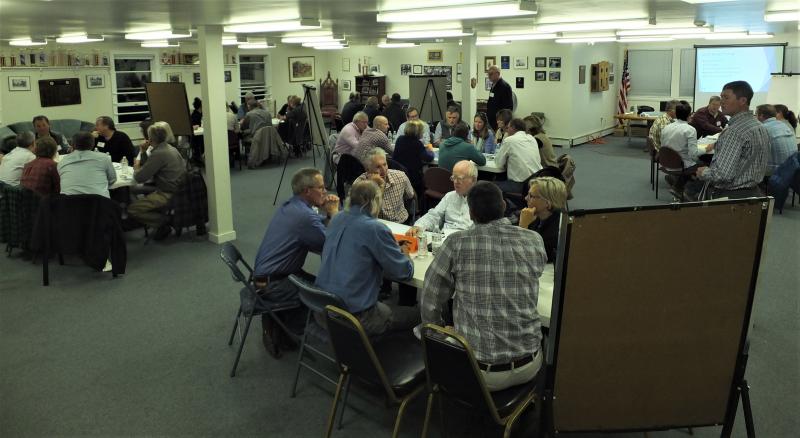Master plan workshop gets communities talking
 The master plan workshop saw Boothbay Region business owners and stakeholders identifying the region’s economic needs and goals. JOSEPH CHARPENTIER/Boothbay Register
The master plan workshop saw Boothbay Region business owners and stakeholders identifying the region’s economic needs and goals. JOSEPH CHARPENTIER/Boothbay Register
 The master plan workshop saw Boothbay Region business owners and stakeholders identifying the region’s economic needs and goals. JOSEPH CHARPENTIER/Boothbay Register
The master plan workshop saw Boothbay Region business owners and stakeholders identifying the region’s economic needs and goals. JOSEPH CHARPENTIER/Boothbay Register
The Joint Economic Development Committee master plan workshop on Thursday, Oct. 12 discuss findings from stakeholder interviews conducted early last month. The interviews centered around building an overall economic development strategy for Edgecomb, Boothbay, Boothbay Harbor and Southport.
The workshop featured the panel who conducted the interviews — Jim Damicus, senior vice president of Camoin Associates; Mitchell Rasor, principal at MRLD Landscape Architecture; and Travis Pryor, team leader at Wright-Pierce.
JEDC co-chairs Wendy Wolf and Abbe Levin opened the evening by explaining what the JEDC’s purpose is.
“Each of us are too small to do this on our own,” Wolf said. “One of the reasons you were invited here tonight is to work with our consultant team, Camoin Associates. One of the things the ... team determined is that, we’ve got a lot of good ideas and input from many members and business leaders, but none of us are experts on economic development.”
Damicus then summarized the findings. The goal was not to make any final consensus on what the region needs to do to bolster economic success, but to draft some ideas on what could be done to react to challenges and to seize opportunities.
“There are tons of natural assets,” said Damicus, citing the harbor, trails, YMCA, Coastal Maine Botanical Gardens, Bigelow Laboratories, Opera House, Boothbay Harbor Country Club, and resorts.
“It is very difficult for your employers to find skilled workers,” said Damicus. “So, what I will tell you is, there is not a project I’m involved in across this country where this is not a major challenge right now. When you move into the state of Maine, that’s off the beaten path with a small population, it gets even worse. And then you put yourself on a peninsula, that becomes an even worse challenge.”
Demographic changes were next in the team’s notes with Damicus stating an aging population makes the difficulties of diminishing workforce and housing seven more of a challenge. Housing came up in almost every interview, Damicus said. It also relates to workforce and the ability to live and is key in creating the environment to successfully develop, he said.
The findings also showed lacking in broadband internet diversity and access as a major challenge. For small businesses and entrepreneurs to succeed and to look at an area like the Boothbay region, broadband is more than convenience — it is a necessity in an increasingly digital world.
“I do believe that unlike Bar Harbor, Acadia, and some other places, I don’t think Boothbay now is as recognized as it once was as a destination,” Damicus said. “I think it’s a bit disjointed in terms of who’s doing marketing and in terms of ‘Why would I want to come to this area?’”
The team’s frankness did have a “but”: the fact that, in Camoin Associates’ experience, the communities working together on inter-economic interests are few and far between.
“You are dealing with issues, which are regional issues. They are not town issues. I commend you on that — that is a real opportunity,” Damicus said.
The JEDC asked the room to split into groups to sit and discuss six goal areas — housing, transportation, downtown development, tourism, working together, and business growth and development.
Jon Dunsford, at the housing table, said, “… Gotta fit more houses under one roof…” while Sewall Maddocks, at the business growth and development table, remarked on how the closet and woodshed rooms that once housed seasonal workers have been glorified into vacation getaways. At the transportation table, Andy Hamblett put the idea of transit and recreational bike lanes on the table while the downtown development table was agreeing on how dark the downtown area is in places it never used to be.
The groups were stopped after 30 to 40 minutes to speak to the rest of the room on the issues that were highlighted, opportunities which should be seized, and potential solutions to problems sketched during conversations.
The housing group touched on the need to consider expansions on water, sewer, and broadband internet if more housing is to come to the area, and said education on zoning changes and tax structures for residents and business owners is quite important for housing expansion. For a tangible solution, the table proposed a 50-unit housing expansion, a start to addressing a shortage in living quarters for the local workforce and accessible living for the elderly.
The downtown development table wished to see a longer tourist season, a more vibrant diversity of shops, restaurants, and lodging, and a downtown that is not virtually shut down after tourists leave until the next season. The group also said it would like to see better accessibility for pedestrians with better sidewalks, docking situations, and signage.
The tourism table also wanted to see the tourist season extended — preferably year-round — and more partnerships between land trusts and chambers of commerce. Regional tourism was a big point discussed at the table as a partnership between chambers of commerce could put a regional focus on marketing.
The same group discussed towns working together to save money, paperwork and time on projects and mutual interests, and members wished to see resources from public works to police departments pull together as wells as regional committees in addition to the various town committees which they said can operate disjointedly without good communication.
The business growth and development table focused on the importance of supporting small and home-based businesses, and entrepreneurs. With the renowned coastal Maine work ethic, and strong senses of local communities with well-educated populations and good schools, a focus also landed on the importance of seasonal businesses becoming year-round and the creation of year-round business. The challenges the table acknowledged were infrastructure needs and financial needs while the opportunities focused on the boon of low land cost and low taxes.
Finally, the transportation table focused on the methods of travel in two groupings — physical and technological. The physical portion centered around walking, biking, public and water transportation; the technological, on broadband internet. The table pondered the beautification of roads, sidewalks, trails and signs, and the idea of satellite parking areas with transportation into town to address traffic and parking conditions. The group branded one of its ideas as “economic pocket identification” which would optimize how transportation is considered once the clusters of spots people pay special interest to are identified. There was consensus on better broadband, internet infrastructure, and internet connectivity with the final goals centering around high-speed internet, seasonal or year-round public transport, and complete streets concept involving sidewalks and beautification.
“The discourse was very positive overall and these were tough issues,” said Damicus. “We’re overhearing property taxes, regional transportation, and public transportation, with regional efforts, and yet no one was screaming or yelling.”
Damicus said the next steps will be a summary of the day’s conversation and findings. The team will develop strategies toward the the goals identified from the evening and present them to the JEDC.
“Then we will have a final plan presentation which will be a report … (with) appendices that have data. There will be narrative, but the body of the report will really be … what we call an action plan matrix,” with a vision, a goal, and how to make it happen.
“There isn’t a town in Maine that isn’t thinking about how they can jumpstart their economy and we are competing with all of them,” said Wolf. “We need everybody’s best thinking and their shoulder to the wheel if we’re going to be successful.”
Event Date
Address
United States



























